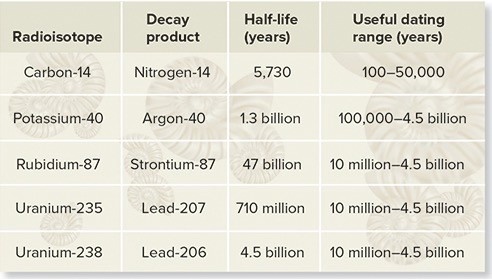You uncovered a fossil that you suspect is around 100 million years old. Which of the radioisotope pairs in the table below could you eliminate as an appropriate choice for radioisotope dating the accompanying rock? 
A. Uranium-235/Lead-207 (half-life = 710 million years; useful dating range = 10 million-4.5 billion years)
B. Uranium-238/Lead-206 (half-life 4.5 billion years; useful dating range = 10 million-4.5 billion years)
C. Potassium-40/Argon-40 (half-life = 1.3 billion years; useful dating range =100,000-4.5 billion years)
D. Carbon-14/Nitrogen-14 (half-life = 5,730 years; useful dating range = 100-50,000 years)
E. Rubidium-87/Strontium-87 (half-life = 47 billion years; useful dating range = 10 million-4.5 billion years)
Answer: D
You might also like to view...
In prokaryotic cells (bacteria), DNA replication would occur in the
a. Cytoplasm b. Cell membrane c. Ribosome d. Nucleus e. Stroma
Which group of fishes evolved most recently (in other words, is the youngest)?
A. Jawless fishes B. Bony fishes C. Hagfishes D. Cartilaginous fishes
The theory of blending inheritance was shown to be false by Mendel’s observations of dominant and recessive alleles
__________________ Indicate whether the statement is true or false.
Multicellularity enables organisms to overcome cellular limits and
A) be photosynthetic. B) become fast. C) reproduce more efficiently. D) become big. E) undergo aerobic respiration.